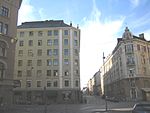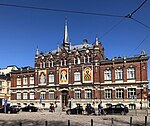Normal Lyceum of Helsinki

Normal Lyceum of Helsinki (In Finnish; Helsingin normaalilyseo) is a school in Helsinki, Finland, consisting of the upper part of primary school (peruskoulun yläaste, grades 7 to 9) and secondary school (lukio). Unlike most other schools in Helsinki, the school is not owned by the city of Helsinki, but is instead part of the University of Helsinki, which itself is owned directly by the state of Finland. The school is considered one of the most prestigious. It is the second hardest to get into, in the entire country, tied with Ressun Lukio. The most difficult one is Helsingin yliopiston Viikin normaalikoulu, which is also owned by the University of Helsinki. The established nickname for the school is Norssi, which also means a student of the school. Former students who have graduated from the school are called vanha Norssi (Finnish for "old Norssi"). The school has a constant, good-natured rivalry with Ressun lukio (Ressu Upper Secondary School, previously known as "Helsingin reaalilyseo") and Helsingin Suomalainen Yhteiskoulu which are considered even more prestigious than the Normal Lyceum by some.
Excerpt from the Wikipedia article Normal Lyceum of Helsinki (License: CC BY-SA 3.0, Authors, Images).Normal Lyceum of Helsinki
Ratakatu, Helsinki Punavuori (Southern major district)
Geographical coordinates (GPS) Address Nearby Places Show on map
Geographical coordinates (GPS)
| Latitude | Longitude |
|---|---|
| N 60.162638888889 ° | E 24.943472222222 ° |
Address
Helsingin normaalilyseo
Ratakatu
00120 Helsinki, Punavuori (Southern major district)
Finland
Open on Google Maps











